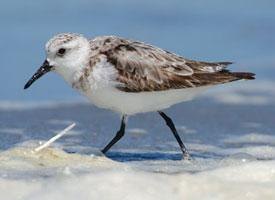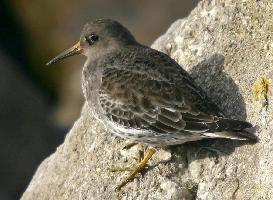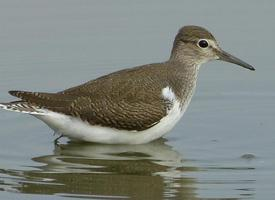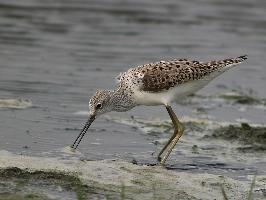
Descrierea animalului
The Little Stint, scientifically named Calidris minuta, is a diminutive wader belonging to the family Scolopacidae, which is renowned for its diverse range of sandpipers and allies. This tiny bird is an epitome of resilience and endurance, undertaking remarkable migratory journeys across vast distances. Its name, "minuta," Latin for "small," aptly describes its stature, as it is one of the smallest sandpipers, with a length of just about 13-15 cm and a wingspan that ranges from 27 to 30 cm.Physical Appearance:
The Little Stint has a compact body with a short neck and a small head, giving it a somewhat rounded appearance. Its bill is short and fine, adapted for picking small invertebrates from mudflats and shallow waters. During the breeding season, it dons a striking plumage with rich chestnut tones on its upper parts and a distinctive pattern of black and white on its face and neck. The breast may show variable amounts of spotting. In contrast, its non-breeding plumage is drabber, featuring duller gray-brown tones above and a clean white underbelly. The legs are dark and relatively short, contributing to its distinctive, bustling gait as it moves along the water's edge.
Habitat and Distribution:
The Little Stint is a highly migratory species, breeding in the high Arctic tundra of northern Europe and Asia. It is a bird of extremes, nesting in the cold, barren landscapes near the limits of terrestrial life, and wintering in warmer climates. Its wintering grounds span the Mediterranean, Africa, the Middle East, and the Indian subcontinent, reaching as far south as southern Africa. During migration, it can be found in a variety of wetland habitats, from coastal mudflats and estuaries to inland lakes and rivers.
Behavior and Diet:
This species is known for its agility and quick movements, often seen darting along the water's edge in search of food. It feeds primarily on a diet of small invertebrates, including insects, crustaceans, and mollusks, which it picks from the surface of mud or shallow water. The Little Stint is a gregarious bird, especially outside the breeding season, forming flocks that can sometimes include hundreds of individuals, along with other species of waders.
Breeding:
The breeding season sees the Little Stint heading to the Arctic tundra, where it nests in a simple scrape on the ground, lined with leaves and grass. The female lays a clutch of 3-4 eggs, which both parents incubate. The chicks are precocial, able to leave the nest shortly after hatching and fend for themselves, with some parental guidance, particularly in finding food.
Conservation Status:
The Little Stint is currently listed as Least Concern by the IUCN Red List, thanks to its wide range and relatively stable population size. However, like many migratory species, it faces threats from habitat loss and degradation, particularly in its wintering and stopover sites due to wetland drainage, pollution, and human disturbance. Climate change also poses a long-term threat, potentially impacting its breeding habitat in the Arctic.
In conclusion, the Little Stint is a remarkable example of nature's resilience, a tiny bird that navigates the extremes of our planet's ecosystems. Its life cycle, from the barren Arctic breeding grounds to the rich, diverse wetlands of the warmer latitudes, underscores the interconnectedness of global ecosystems and the importance of conserving migratory bird habitats across continents.
Animale similare
Fotografii noi cu animale
Top 10 animale
- Diana monkey (Cercopithecus diana)
- Dolphin gull (Leucophaeus scoresbii)
- Galápagos tortoise (Geochelone nigra complex)
- Moustached guenon (Cercopithecus cephus)
- Japanese spider crab (Macrocheira kaempferi)
- Colossal squid (Mesonychoteuthis hamiltoni)
- Fox tapeworm (Echinococcus multilocularis)
- Stone loach (Barbatula barbatula)
- Japanese macaque (Macaca fuscata)
- Barbary macaque (Macaca sylvanus)


